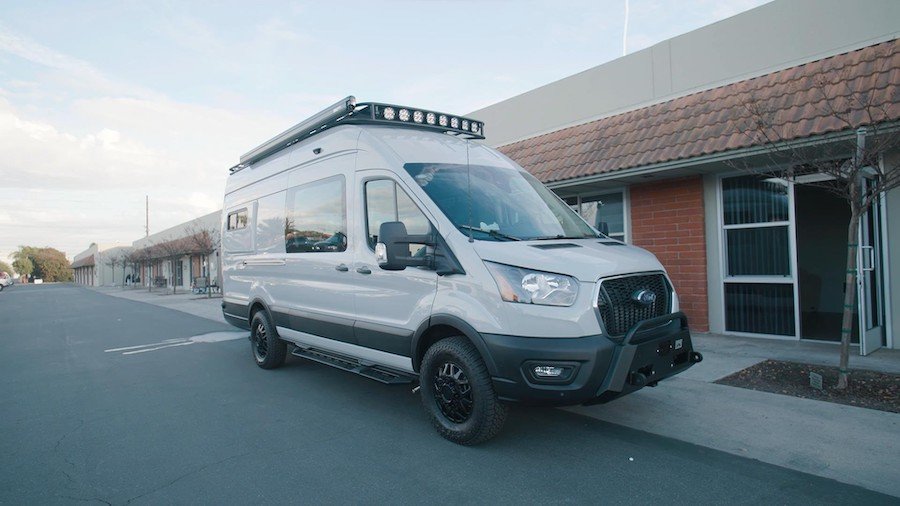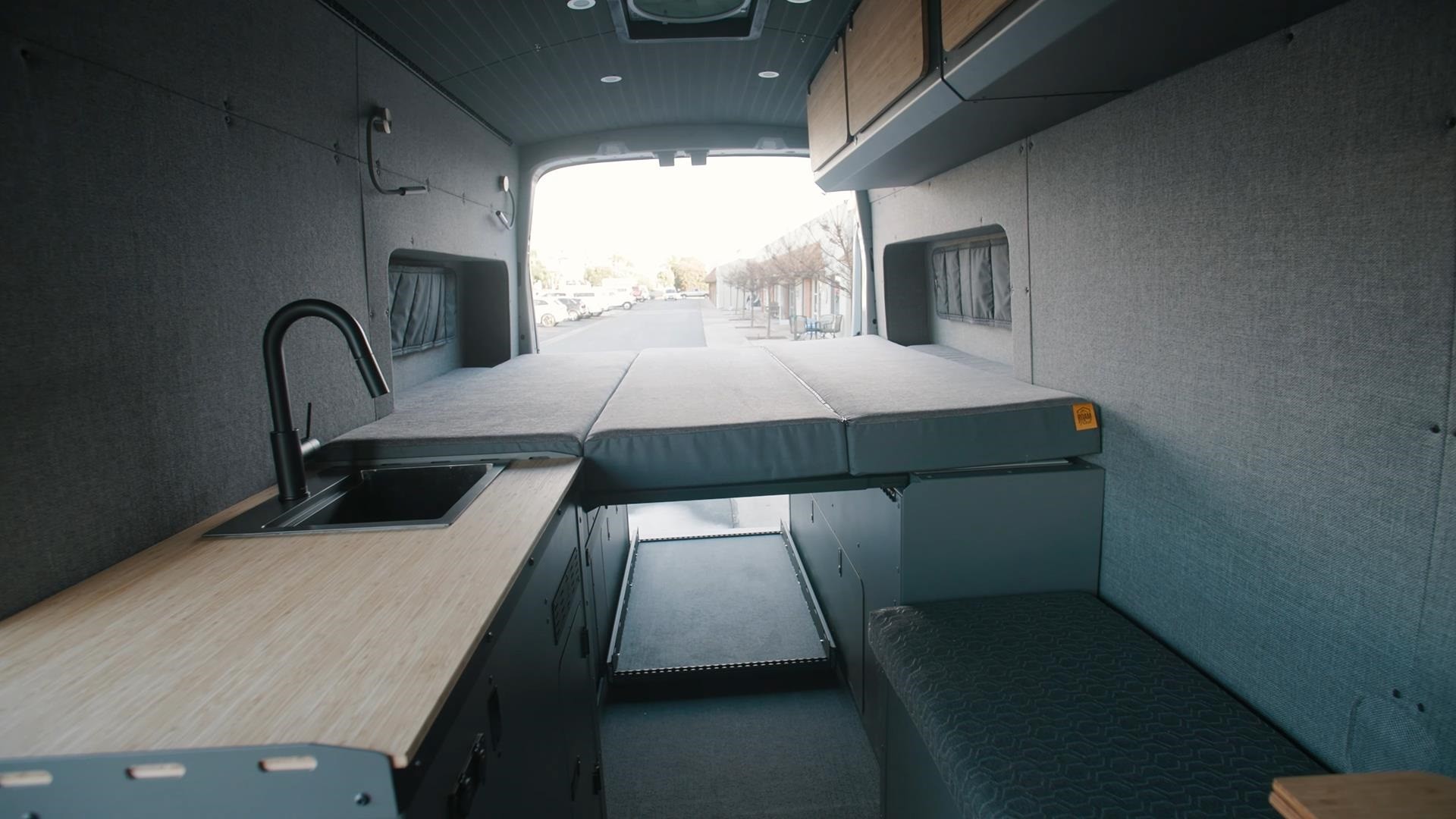Trail Ready Ford Transit Camper Van Is an Ultra Functional, Thoroughly-Equipped Tiny Home

What we have here is a 2023 Ford Transit AWD camper conversion made by Gone Mobile Vans, a California-based company specializing in Transit and Sprinter conversions. This rig is ready to take you wherever you want to go while keeping you in a superior level of comfort.
The camper is based on a high-roof, extended 148" wheelbase Transit. It sports a 3.5-liter EcoBoost V6 engine outputting 310 hp and 410 ft-lb. (558 Nm). Moreover, the rig has a Vancompass Topo 2.0 lift kit, which offers a 2-inch lift and significantly improves the van's ride quality. For wheels, Gone Mobile Vans opted for Hostile Roam 136 wheels wrapped in Falken Wildpeak all-terrain tires.
Let's start with the exterior features. At the front, you'll discover an Aluminess Baja bumper complete with a front receiver and two recovery points. On top, the builders added a low-profile Aluminess roof rack with a Baja Design light bar. Furthermore, the roof rack also holds a Fiamma awning, a WeBoost antenna, a 200 W solar panel, a Maxxair fan, and a Nomadic A/C.
As you can already tell, Gone Mobile Vans is into Aluminess products. The company fitted newly-designed Aluminess running boards. Also, on the sides, you'll notice a ladder on the driver's side, as well as flares whose color matches the vehicle's Avalance Grey finish.
Finally, at the rear, you'll notice an Aluminess rear door tire carrier holding a spare and an Aluminess storage box attached to an Aluminess Backpack mounting plate.
So far, so good. This Transit is equipped with many accessories and is clearly prepared to go off the beaten path. But let's see how cozy the interior is. As soon as you step inside, you'll notice the almost-all-grey interior, which I can't say I'm a fan of, but that's just my taste. I love having pops of colors, and besides the overhead bamboo panels and the bamboo tabletop, everything in this van's interior has the same color. But vans are built per the customer's requests, so this is what this van's customer wanted.
But let's forget about aesthetics for a second and look behind what we can see. Gone Mobiel Vans have made sure you'll be nice and warm in their camper. If you take its wall apart, you'll find the following layer (in this order, from the outside in): covering the sheet metal is a sound-deadening material, 3M Thinsulate, ¾-inch thick Baltic Birch panels, and the final layer of Marathon charcoal-colored fabric, which you'll notice all around the interior. For the floor, the company added a ¾-inch thick composite foam and fiberglass covered by a 2tek2 woven vinyl flooring.
Step inside the driver's cabin, and you'll discover that this vehicle has some much-needed extra features, including a Sync4 HD display, a full-time rear-view camera, and a 360 camera that makes parking easier. Moreover, the driver's and passenger's seats can be swiveled.
Mounted inside the van's B-pillar is a Lagun table with a bamboo top. It's perfect to be used when the passenger seat is swiveled, but it can also be extended outside the van to enjoy a drink. What's more, it can be detached and mounted near the seating area.
You'll discover the seating area dead ahead as you enter. It might be a bit of a stretch to call it a seating area, as it consists of a long bench with a waterproof 3-inch (7.6-centimeter) cushion. In one of its parts, Gone Mobile Vans integrated one of the most popular options, a Wrappon toilet. This piece of equipment hermetically seals waste and odor in polyethylene bags, making it easy for you to clean it.
Above, you'll discover four Lost Hiway Transit-specific cabinets with bamboo doors, which offer plenty of storage. One of them holds an AC outlet and a WeBoost antenna.
Next, we have the 32-inch (81-centimeter) galley kitchen, located just by the sliding door. Even though it's quite compact compared to other kitchens I've seen in vans, it's decently equipped. I also love its utilitarian design. It features an Isotherm fridge/freezer mounted on a drawer mount, a long drawer above it, switches for the grey tank and the water pump, a bamboo countertop that integrates a tiny sink, and a door that hides the sink's plumbing system. For cooking, you'll need a portable stove, ideally an induction one, so you can easily connect it to an outlet.
The rear part of the interior boasts two 72-inch Lost Hiway fender boxes, one on each side. You don't get a garage in this van, but these two offer a decent amount of storage space. But before I tell you more about what you can find inside them, let's see how comfortable this bed setup is.
You don't need to worry about being cramped in this rig's bed. It measures 72 inches (183 centimeters) front-to-back and a whopping 80 inches (203 centimeters) wide due to the flares I mentioned earlier, which create additional space. That means you can set it up to sleep from side to side if you want it to be as long as possible.
This van's client opted for a Roam Rest tri-fold mattress, which can be easily folded out of the way. Then, you just have to remove the panels the mattress is sitting on, and you get plenty of room to walk around or store bulkier items.
Many people, myself included, would like to have a shower inside the van. You might be thinking this is another rig without an interior shower. However, even though there isn't any fixed place for it, Gone Mobile Vans unleashed its creativity and managed to fit a shower system.
The company chose a Tetravan folding shower pan, which is integrated into the passenger-side fender box. To set it up, you'll have to fold down the pan, attach a curtain to the ceiling, and you're good to go.
Both fender boxes have an openable top that reveals large storage spaces. Under those, you'll find the van's utility system. The driver's side fender box houses the electrical system, a 5 kW EcoFlow power kit, which features an equivalent of about 400 Ah battery power. What's more, you can add 5 more Kw if needed, even 10 kW. Gone Mobile Vans says this current setup can power the van for a couple of days.
On the opposite side, the builders added the water system, consisting of a 24-gallon (91-liter) freshwater tank with easily accessible plumbing. It's connected to a rear external shower with a pull-out shower wand that gives off both hot and cold water. While we're on the topic of utilities, I forgot to mention there's also a Webasto heater fitted for colder days.
The rearest part of the "hallway" holds a Lost Hiwat gear tray that's 48 inches (122 centimeters) deep. It comes with an integrated L-Trak and can be extended outside for easier access.
All in all, this is a well-equipped van fitted with high-quality materials. It can take you off-road and off-grid and keep you safe and comfortable. But the big question you're probably thinking of is, "How much?"
Well, Gone Mobile Vans hasn't offered an exact price for the rig, but based on another of the company's listings, you can expect to empty out around $130,000 to $140,000 (€118,197 to €127,289) for this camper, if not a bit more. The base vehicle is around $60,000 (€54,552) new, meaning the conversion costs $70,000 to $80,000 (€63,644 to €72,736). Keep in mind these are just my estimates. You can learn more about Gone Mobile Vans and its rigs on its website.


Related News
